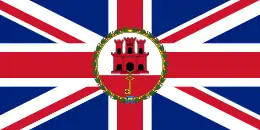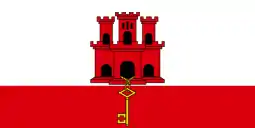Sir William Houston, 1st Baronet
General Sir William Houston, 1st Baronet GCB GCH KC (10 August 1766 – 8 April 1842) was a General in the British Army and the Governor of Gibraltar.
Sir William Houston | |
|---|---|
| Born | 10 August 1766 |
| Died | 8 April 1842 (aged 75) Bromley Hill, Kent |
| Buried | |
| Allegiance | |
| Service/ | British Army |
| Rank | General |
| Battles/wars | French Revolutionary Wars Peninsular War |
| Awards | Knight Grand Cross of the Order of the Bath Knight Grand Cross of the Royal Guelphic Order Order of the Crescent |
Military career
Houston was commissioned into the 31st (Huntingdonshire) Regiment of Foot in 1781.[1] He commanded the 58th Regiment of Foot at the Capture of Minorca in 1798.[2] Later he commanded a Brigade at the Siege of Alexandria for which he received the Turkish Order of the Crescent, second class (KC). He also commanded the 7th Division during the Battle of Fuentes de Onoro in 1811 and at the Siege of Badajoz in 1812.[2] He became Lieutenant-Governor of Portsmouth and General Officer Commanding South-West District in January 1814.[3]
Houston was Governor of Gibraltar from 8 April 1831 to 28 February 1835.[2] He set up the first official free school on Flat Bastion Road in Gibraltar whilst he was governor in 1832.[4] By the end of his career in the British Army he became a General in 1837.[5]
From 1825 to the accession of Queen Victoria in 1837 he served as a Groom of the Bedchamber to both King George IV and King William IV.[6]
He was created a baronet on 19 July 1836.[7]
He died at Bromley Hill on 8 April 1842 and was interred in the catacombs at West Norwood Cemetery.[8]
Personal life
On 5 November 1808 he married Lady Jane Maitland, the fourth daughter of James Maitland, 7th Earl of Lauderdale and widow of Samuel Long, who was the brother of Lord Farnborough. William and Mary had two sons together, Sir George Augustus Frederick Houston (b.1809), an army officer and William, who became a captain in the 10th Hussars. William's daughter was a prolific writer, Matilda Charlotte Houstoun.[9] Lady Jane died on 1 June 1833.[10]
References
- "No. 12210". The London Gazette. 28 July 1781. p. 1.
- William Houston at Oxford Dictionary of National Biography
- "No. 16851". The London Gazette. 1 February 1814. p. 262.
- Dundas, Susan Irene (2000). "Methodism in Gibraltar and its mission in Spain, 1769-1842". Durham Etheses. Retrieved 30 June 2013.
- "No. 19456". The London Gazette. 10 January 1837. p. 63.
- "Court officers" (PDF). Retrieved 25 April 2016.
- "No. 19395". The London Gazette. 28 June 1836. p. 1177.
- West Norwood Cemetery, Burial register index & purchase register, Catacomb No.16H
- The Peerage and Baronetage of the British Empire as at Present Existing, Edmund Lodge, 1877, page 694
- The Gentleman's Magazine. W. Pickering. 1842. p. 93.
Sources
- Kidd, Charles, Williamson, David (editors). Debrett's Peerage and Baronetage (1990 edition). New York: St Martin's Press, 1990.
- Leigh Rayment's list of baronets
 This article incorporates text from a publication now in the public domain: "Houston, William (1766-1842)". Dictionary of National Biography. London: Smith, Elder & Co. 1885–1900.
This article incorporates text from a publication now in the public domain: "Houston, William (1766-1842)". Dictionary of National Biography. London: Smith, Elder & Co. 1885–1900.
| Military offices | ||
|---|---|---|
| Preceded by Sir Thomas Maitland |
GOC South-West District January 1814 – September 1814 |
Succeeded by Lord Howard |
| Preceded by Sir John Stuart |
Colonel of the 20th (the East Devonshire) Regiment of Foot 1815–1842 |
Succeeded by Sir James Burns |
| Government offices | ||
| Preceded by George Don (acting) |
Governor of Gibraltar (acting) 1831–1835 |
Succeeded by Sir Alexander Woodford |
| Baronetage of the United Kingdom | ||
| Preceded by New creation |
Baronet 1836–1842 |
Succeeded by George Houstoun-Boswall |

